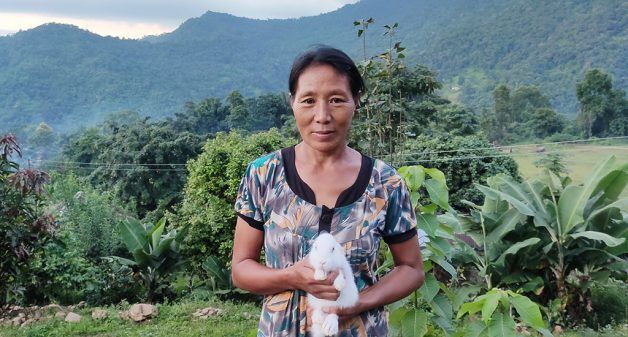
Women bet big on rearing rabbits
Rearing rabbits is becoming one of the most lucrative and profitable businesses for women in Nagaland thanks to the huge demand for rabbit meat and low farming costs.

Rearing rabbits is becoming one of the most lucrative and profitable businesses for women in Nagaland thanks to the huge demand for rabbit meat and low farming costs.
Nibuno Kuotsu lives in a pristine village surrounded by a green canopy of mountains and blue skies in the Kohima district of Nagaland, around 50 kilometres from the state capital.
Though she lives in an idyllic spot sought out by many nature lovers, her house is made of tin and supported by bamboo pillars. The measly income her family makes from farming is not enough to help them afford a better home.
That is why the 50-year-old homemaker has pinned her hopes on rabbit farming, easily reared in her backyard.
Unlike other animals, rabbits don’t require special feed, large plots of land or expensive kennels, making it a more profitable venture.
Advantages of rearing rabbit
Nibuno Kuotsu has six rabbits in an easily assembled cage built using wood and iron mesh, with nails holding it in place. Feeding her livestock is simple too.
“Rabbits survive on kitchen waste, green leaves and even carrots. That saves our cost of feeding them,” she said.

The meat is also in high demand in the region because of its taste and nutritional value.
“People make prior bookings for it,” she chuckled.
She can easily make up to Rs 5,000 through rabbit rearing, but often she gifts the animals. “Since we all consume non-vegetarian food mostly, we like to gift the rabbits. Rabbit meat is highly nutritious and gifting, especially to sick people is seen as a good gesture.”
Her neighbour, 30-year-old Pelenguno Kuotsu, sells a pair of small rabbits for Rs 700 and a single rabbit for Rs 350 per kg. The rate varies depending upon the location, costing less in villages than in towns.
“We normally sell the animals to other villagers, who buy either for consumption or for breeding. We don’t sell our adult males though, as they’re kept for breeding purposes,” Pelenguno Kuotsu said.
Hopping cottage industry
Unlike other parts of the country, land-locked Nagaland does not have many livelihood opportunities because of its remoteness and inaccessibility. Keeping track of livestock over undulating terrain is one issue, but even harder is getting feed delivered to them. It is neither easy nor cheap. So rabbit rearing is proving an ideal way for women to help supplement their family’s income.

The government encourages this booming cottage industry.
“The government offers monetary help to the poor for building cages. It’s more profitable than other livestock farming as the feed cost is quite high in Nagaland, but rabbits can be fed with kitchen waste,” said Elizabeth Yhome, deputy director, Department of Veterinary and Animal Husbandry, Nagaland.
Small eaters but fast breeders
It is not just the simple diets of rabbits or their small size that makes them easy livestock to keep. They have another innate characteristic that makes them ideal – their prolific breeding habits.
“It can breed 4-5 times a year. The pregnancy period is 30 days. The average rabbit can produce 20-25 bunnies in a year. It matures fast, and is ready to produce a litter in 6-7 months,” said Rokonienuo, a veterinarian based in Kohima.
“The fur of the skin can also be utilised for making jackets, hand gloves, caps, etc,” Rokonienuo added.
Even women in towns and cities rear rabbits
The culture of rabbit farming, however, is not limited to the districts. Women in towns and cities are also rearing rabbits.

Over 30,000 women in Nagaland are involved in rabbit rearing.
Achila Zhotso, a 45-year-old homemaker who lives in the state capital, Kohima, has been involved in rabbit rearing for the past five years.
“I sell a single, fully grown adult for Rs 2,000 and a pair of small rabbits also at the same price. People buy for consumption and also for breeding in order to start a similar trade,” she said.
Scaling up difficulties
The small, cute mammals might be prolific but the rabbit rearing business is hard to scale up.
Lack of proper knowledge – about maintaining the animals in all seasons, never mind running larger businesses – has prevented most women from scaling up their rabbit ventures.
“Unlike other parts of the country, the season normally remains cold across the year and it’s chilly during winters. Six rabbits of mine died a few weeks ago, which resulted in big losses. That put me off getting completely involved in rabbit farming,” Nibuno Kuotsu said.
“During winters, rabbits face problems and normally people sell them off prior to Christmas to make a fresh beginning in the New Year,” Yhome said.
She said the government does hold training sessions on the upkeep of livestock from time to time. But for most of the small-scale farmers, it is not enough.
Gurvinder Singh is a journalist based in Kolkata. He writes about livelihoods, organic farming and rural issues.